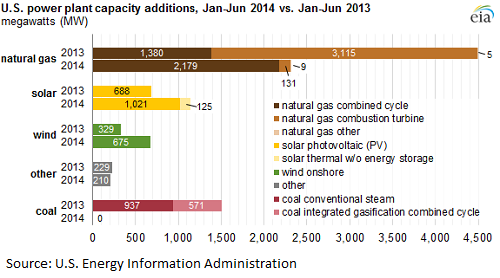 Broadwind Energy, Inc. has announced $14 million in new tower orders from a U.S. wind turbine manufacturer. Broadwind will produce these towers in its Manitowoc, Wisconsin and Abilene, Texas facilities.
Broadwind Energy, Inc. has announced $14 million in new tower orders from a U.S. wind turbine manufacturer. Broadwind will produce these towers in its Manitowoc, Wisconsin and Abilene, Texas facilities.- The 14th Annual Renewable Energy Roundup & Sustainable Living Expo starts on Friday, September 26th with the Grand Opening & “Save The Planet? – Kids Are The Answer,” a free educational opportunity for Middle and High School age youth to participate in special environmental educational activities. The Roundup is September 26 – 28 and takes place in Belton at the Bell County Expo Center, 301 W Loop 121 (at IH-35), Belton, TX 76513.
- Toshiba has been selected as the battery supplier for the next generation, all-electric, zero-emission bus from Proterra Inc., the leading electric vehicle (EV) transit bus manufacturer. The new fleet will use Toshiba’s Rechargeable Batteries (SCiB™), a safe rechargeable battery solution with high-rate performance and long-life capabilities that is used in a wide range of applications, from EVs to grid energy storage.
- SunEdison, Inc. announced that Google Inc. has agreed to provide $145 million in equity financing for the Regulus solar plant. When completed, the Regulus solar project will be SunEdison’s largest developed and constructed project in North America. Located in Kern County, Calif., the Regulus plant will begin operation later this year, and will supply power to Southern California Edison through a 20-year power purchase agreement.
Introducing Cellulosic Technology Cellerate
During the cellulosic ethanol celebration event at Quad County Corn Processors ethanol plant in Galva, Iowa yesterday, Syngenta unveiled the new brand for the cellulosic ethanol technology: Cellerate™. Enhanced by Enogen® corn enzyme technology, Cellerate is a collaboration between Syngenta and Cellulosic Ethanol Technologies, LLC.
Cellerate is unique in that it is designed to increase an ethanol plant’s production by  allowing the corn kernel fiber to be converted into cellulosic ethanol. Ethanol plants can easily integrate Cellerate process technology into their existing production process. Cellerate, in conjunction with Enogen corn, will deliver notable benefits to ethanol plants beyond what can be achieved through either technology alone.
allowing the corn kernel fiber to be converted into cellulosic ethanol. Ethanol plants can easily integrate Cellerate process technology into their existing production process. Cellerate, in conjunction with Enogen corn, will deliver notable benefits to ethanol plants beyond what can be achieved through either technology alone.
“The combination of Cellerate and Enogen represents the next leap forward in ethanol production,” said Jack Bernens, head of marketing and stakeholder relations for Enogen corn enzyme technology at Syngenta. “Ethanol is helping America reduce its dependence on foreign oil, lower prices at the pump, improve the environment with lower emissions, and grow the economy with jobs that can’t be outsourced. Together, these technologies will make ethanol more sustainable.”
In July 2014, collaboration between Syngenta and Cellulosic Ethanol Technologies, LLC, a wholly owned subsidiary of Quad County Corn Processors (QCCP), produced the first commercial-scale cellulosic ethanol in Iowa.
“The synergy of Cellerate and Enogen will decrease natural gas usage and increase ethanol throughput, while reducing a plant’s carbon footprint,” said Delayne Johnson, chief executive officer of QCCP. “These advantages, combined with higher protein DDGs and increased corn oil production, make the technology package appealing for ethanol plants looking to improve their bottom line.”
New Calif. Law to Crack Down on Biodiesel Grease Thieves
 The State of California will be cracking down on thieves of a popular biodiesel feedstock – used cooking grease. This article from the San Diego Union-Tribune says the new law is expected to be signed into effect soon and will have tougher penalties, including starting at $1,000 for first-time offenders.
The State of California will be cracking down on thieves of a popular biodiesel feedstock – used cooking grease. This article from the San Diego Union-Tribune says the new law is expected to be signed into effect soon and will have tougher penalties, including starting at $1,000 for first-time offenders.
Backers of the legislation hope harsher penalties, along with new provisions for roadside inspections and record keeping, will translate into more action by law enforcement and prosecutors. Individual oil thefts often qualify as petty theft but cumulatively cost biofuel companies and restaurants millions of dollars each year…
Restaurants, from fast-food to four-star, share in the profits by setting their waste oil aside in liquid containers ranging from 55 gallon drums to 15,000 gallon vats.
Imperial Western Products, which operates in California, Nevada and Arizona and collects oil from hundreds of restaurants in San Diego County, estimates 25 percent or more of its contracted oil gets taken before its trucks arrive.
David Isen, asset protection manager for the Coachella-based company, said thieves have used heavy equipment to haul away locked containers entirely. Motion sensors have helped him document oil theft in the early morning hours. Perpetrators responded, he said, by showing up later and blending into the morning bustle, or posing as cardboard collectors.
“Nobody is afraid of the enforcement,” he said. “We’re losing millions of dollars a year, our company alone.”
California actually has some pretty strict regulations on kitchen grease hauling but not many enforcers. The new law hopes to close some of the loopholes thieves have been exploiting.
Algae & Safflower Biodiesel Flies Across Salt Flats
 A truck running on biodiesel made from algae and safflower seed oil was tearing up the salt flats known for their speed records. This story from KSL in Salt Lake City, Utah says the Utah State University truck first set a record of nearly 135 miles per hour… about 30 miles faster than a small-engine diesel truck has ever gone before… using regular diesel. Then it was time to put the biodiesel blend to the test at the Bonneville Salt Flats.
A truck running on biodiesel made from algae and safflower seed oil was tearing up the salt flats known for their speed records. This story from KSL in Salt Lake City, Utah says the Utah State University truck first set a record of nearly 135 miles per hour… about 30 miles faster than a small-engine diesel truck has ever gone before… using regular diesel. Then it was time to put the biodiesel blend to the test at the Bonneville Salt Flats.
Michael Morgan, a research assistant at Utah State University, was out to prove something.
“Not only can we run it in our everyday cars, but when we want to, come here and run it as fast as we possibly can,” he said.
The diesel fuel his team made with algae and safflower seeds can stack up to the real thing, he said.
“I know that the world only has so many resources. We’re using them up quickly,” he said.
The 20 percent biodiesel blend pushed the truck over 100 miles per hour, but since the salt flats does not take records made using biodiesel, it was just for exhibition.
The group from Utah State dedicated the run to former colleague Dallas Hanks, a great biodiesel advocate from the school who died of cancer this past June.
“We want people to know about the work that he did,” Morgan said.
Quad County Processors Host Grand Opening
The first refinery to produce cellulosic ethanol with a bolt-on process officially opened its doors today.
 “This is a historic day not just for the ethanol plant, but for the entire region,” said Delayne Johnson, CEO of Quad County Corn Processors in Galva, Iowa. “This is a perfect example of cutting edge technology, right here in our backyard and we are thrilled to have our plant using this ingenuity.” The Adding Cellulosic Ethanol (ACE) project, newly re-named “Cellerate,” allows QCCP to produce 2 million gallons of cellulosic ethanol each year from corn kernel fiber at their plant in Galva, Iowa.
“This is a historic day not just for the ethanol plant, but for the entire region,” said Delayne Johnson, CEO of Quad County Corn Processors in Galva, Iowa. “This is a perfect example of cutting edge technology, right here in our backyard and we are thrilled to have our plant using this ingenuity.” The Adding Cellulosic Ethanol (ACE) project, newly re-named “Cellerate,” allows QCCP to produce 2 million gallons of cellulosic ethanol each year from corn kernel fiber at their plant in Galva, Iowa.
“Today’s grand opening is a direct result of the ingenuity and hard work of the employees and shareholders of QCCP, but it’s also a direct result of the kind of innovation that occurs when a policy like the Renewable Fuel Standard (RFS) is in place,” said American Coalition for Ethanol (ACE) Executive Vice President Brian Jennings. “More than any other policy enacted by Congress, the RFS has been a catalyst for innovation, including the kind of technology advancement developed at QCCP to make cellulosic ethanol from corn kernel fiber.”
 Renewable Fuels Association president and CEO Bob Dinneen participated in the grand opening ceremony and praised QCCP, noting, “To the management, staff and investors of Quad County Corn Processors I say a hearty congratulations on your vision and your commitment to seeing it through. To EPA I say get out of Washington and see what is happening in places like Galva, Iowa.”
Renewable Fuels Association president and CEO Bob Dinneen participated in the grand opening ceremony and praised QCCP, noting, “To the management, staff and investors of Quad County Corn Processors I say a hearty congratulations on your vision and your commitment to seeing it through. To EPA I say get out of Washington and see what is happening in places like Galva, Iowa.”
Dinneen tweeted from the event, “Quad Co cellulosic plant can tell Big Oil “we told you so” and make them eat their words!”
Nat Gas, Solar and Wind Lead Power Capacity Adds
During the first half of this year, natural gas, solar and wind lead all sources when it comes to new utility-scale generating capacity to come online. This report from the Energy Information Administration (EIA) says that 4,350 megawatts (MW) of new utility-scale generating capacity came online, with natural gas making up the lion’s share of those additions but solar and wind made bigger proportional gains compared to the first six months of 2013.

Utility-scale capacity additions in the first half of 2014 were 40% less than the capacity additions in the same period last year. Natural gas additions were down by about half, while solar additions were up by nearly 70%. Wind additions in the first half of 2014 were more than double the level in the first half of 2013.
Of the states, Florida added the most capacity (1,210 MW), all of it natural gas combined-cycle capacity. California, with the second-largest level of additions, added just under 1,100 MW, of which about 77% was solar and 21% was wind, with the remaining additions from natural gas and other sources. Utah and Texas combined for another 1,000 MW, nearly all of it natural gas combined-cycle capacity with some solar and wind capacity in Texas.
In addition to the large additions by natural gas, solar saw strong year-on-year growth, adding 1,146 MW. Wind basically more than doubled the amount added in the same period last year, putting 675 MW generating capacity online.
Symposium Examines Critical Energy Infrastructure
The Midwest Energy International Symposium will look at how the U.S. will confront a host of energy environment and infrastructure challenges over the next two years. The event will take place on Thursday, October 9, 2014 at the Quad-Cities Waterfront Convention Center located in Bettendorf, Iowa.
Speakers and panelists will provide valuable information and insights regarding energy  exports including ethanol, biodiesel, biojet fuels and the supply chains and logistics for fuel transport systems including the trucking, railroad and water transport industries.
exports including ethanol, biodiesel, biojet fuels and the supply chains and logistics for fuel transport systems including the trucking, railroad and water transport industries.
The featured keynote speaker is Dr. Gong Ping Yeh, Fermilab with the United States Department of Energy (DOE). His research and interests in sustainable energy include wind, solar, biofuels, electric vehicles and improving energy efficiencies. In recent years, he has focused on Accelerator Driven System and Thorium energy as a new source of energy. Dr. Yeh has been serving internationally as an advisor for sustainable energy in many countries.
Other keynote speakers include:
- Lt. General Wallace “Chip” Gregson, Jr. (Ret.) will address United States Department of Defense Sustainable Energy Projects.
- The Rock Island Arsenal, United States Army, will present energy program models for hydroelectricity.
- Mexico: Creating an Energy Self Sufficient Region in NAFTA, Mexico Energy Ministry
- Korea: Korea’s Energy Future, Global America Business Institute
- Germany: Germany’s Current Energy Transition and Use of Biogas as a Fuel, German American Chamber of Commerce, Chicago.
More information about the event along with registration information can be found here.
California Surpasses 100K Plug-In Car Sales
California is leading the country on plug-in electric vehicle sales and has surpassed the 100,000 sales mark since the market started in 2010 according to the California Plug-In Electric Vehicle Collaborative. California Governor Brown has set a goal to have 1.5 million EVs on state roads by 2025.
“California’s plug-in electric vehicle market is ramping up, and we expect to see significant growth over the next ten years as customers realize how economical and convenient they are,” said California Plug-In Electric Vehicle Collaborative Executive Director Christine Kehoe.
 According to data collected by the California Air Resources Board, new sales figures released this week from hybridcars.com and Baum & Associates, a Michigan-based market research firm, Californians bought 102,440 PEVs from December 2010 through August 2014 accounting for nearly 40 percent of all PEVs sold in the U.S.
According to data collected by the California Air Resources Board, new sales figures released this week from hybridcars.com and Baum & Associates, a Michigan-based market research firm, Californians bought 102,440 PEVs from December 2010 through August 2014 accounting for nearly 40 percent of all PEVs sold in the U.S.
In addition to automakers rolling out dozens of plug-in electric vehicle models for consumers over the next couple of years, utilities are working to provide a clean, reliable and affordable fuel source for plug-in car owners. Drivers also have increasing options to refuel at home overnight or charge at workplaces across the state.
“Electric vehicles are an integral part of California’s cleaner future. With more than 10,000 electric vehicles on the road in the San Diego Gas & Electric service territory today, it is evident that our customers are embracing the benefits of clean electric transportation,” said James P. Avery, SDG&E senior vice president of power supply. “SDG&E is committed to providing our customers with the clean energy, attractive electric rates and resources needed to support their electric vehicle needs.”
According to California Plug-In Electric Vehicle Collaborative driving on electricity is the equivalent of driving for $1 per gallon of gasoline while a gallon of gasoline hovers around the $4 mark in some areas.
Richard Lowenthal, founder and chief technical officer of ChargePoint, a leading company installing EV charging stations at a myriad of public locations throughout the state said of the announcement, “We’re pleased to be providing clean, affordable fuel for a growing number of drivers across the country. Gasoline is 4 dollars a gallon in California and rising. Consumers want alternatives and we’re here to help make the best alternative – electricity — more accessible, and to make electric vehicles more appealing.”
Michigan Next Stop for Ethanol Safety Seminars
Michigan is the next stop for the Ethanol Safety Seminars. Led by the Renewable Fuels Association (RFA) and in conjunction with the Michigan Department of Agriculture, there will be five training stops with the first on September 17 in Albion. Additional seminars will take place on September 18 in Lansing, September 19 in Grand Rapids, September 22 in Saginaw and September 24 in Warren. Each seminar is funded by a Promotion and Alternative Fuels Education grant from the Michigan Department of Agriculture.
 All seminars are free and feature a morning session from 9:00 a.m. to 2:00 p.m. and an evening session from 5:30 to 10:00 p.m. Certificates will be awarded to attendees at the completion of the course. While primarily targeting first responders, hazmat teams, safety managers, and local emergency planning committees, seminars are also open to the general public.
All seminars are free and feature a morning session from 9:00 a.m. to 2:00 p.m. and an evening session from 5:30 to 10:00 p.m. Certificates will be awarded to attendees at the completion of the course. While primarily targeting first responders, hazmat teams, safety managers, and local emergency planning committees, seminars are also open to the general public.
Ethanol Safety Seminars focus on numerous areas including an introduction to ethanol and ethanol-blended fuels, chemical and physical characteristics of ethanol and hydrocarbon fuels, transportation and transfer of ethanol-blended fuels, storage and dispensing locations, firefighting foam principles and ethanol-blended fuel, health and safety considerations for ethanol-blended fuel emergencies and tank farm and bulk storage fire incidents.
“With nearly 14 billion gallons of ethanol flowing across our country via railroads, highway cargo tank trucks, and barges, it’s vital that our first responders know how to safely and effectively handle the situation should a spill occur,” said Craig VanBuren, consumer protection section director at the Michigan Department of Agriculture. “This grant allows the Renewable Fuels Association the opportunity to provide boots-on-the-ground training for our emergency responders if an ethanol spill were to happen.”
In addition to the seminars, RFA will also host five free retailer workshops throughout the state on how to market ethanol-blended fuels, including E15, E85, and all mid-level blends in between. The workshops will discuss economics, the process of capturing RINs, equipment options, buying fuel locally, and available incentives to offset investment. Workshops will take place on Sept. 16 in Warren and Flint, Sept. 17 in Grand Rapids and Kalamazoo, and Sept. 18 in Ann Arbor.
Energy Management Solutions Signs New Agreements
Energy Management Solutions, Inc. (EMS), a subsidiary of ICM ,has signed two new plant management agreements with Red River Energy LLC, located in Rosholt, South Dakota and Midwest Renewable Energy LLC, located in Sutherland, Nebraska.
 The Red River Energy ethanol plant will come back online and into full production this week after sitting idle for the past 18 months. The plant has an operating capacity of 25 million gallons of ethanol per year. The Midwest Renewable Energy plant is currently operating at a capacity of 22 million gallons of ethanol per year.
The Red River Energy ethanol plant will come back online and into full production this week after sitting idle for the past 18 months. The plant has an operating capacity of 25 million gallons of ethanol per year. The Midwest Renewable Energy plant is currently operating at a capacity of 22 million gallons of ethanol per year.
Dave VanderGriend, CEO of ICM said, “We are excited about expanding our plant management efforts with the addition of these two facilities. We’re proud to be their operator of choice and we look forward to helping each plant run as efficiently as possible.”
In addition to these newly signed contracts, EMS provides plant management services for Tharaldson Ethanol, Casselton, North Dakota and Noble Americas South Bend Ethanol LLC, South Bend, Indiana., which is scheduled to come online in the 4th quarter of this year.

